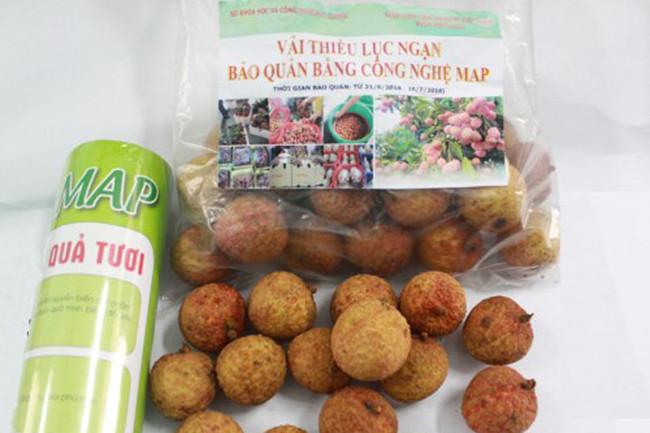The female doctor of low-cost technology keeps fresh lychee for over a month
Dr. Pham Thi Thu Ha (Institute of Chemistry, Academy of Science and Technology) and colleagues have successfully developed the process of preserving litchi with modified atmospheric packaging film (MAP) to help litchi can be fresh delicious for more than 1 month.
MAP manufacturing technology has been researched and developed by Institute of Chemistry since 2008. This type of membrane is made from thermoplastic resins in primary form, ensuring food safety and hygiene.
A special feature of this MAP film fabrication technology has been added by some researchers to help MAP membranes have selective gas permeability - CO2 absorption and oxygen injection, to limit the respiratory process of fruits. keep fresher, not stagnant water, waterlogged inside like traditional membranes, bags.
In early 2015, Dr. Pham Thi Thu Ha and her colleagues at the Institute of Chemistry (VAST) were assigned the research topic, applied MAP membrane to preserve litchi and prolonged preservation period at least 4 weeks in order to Stable quality and color of litchi fruit.

Lychee is preserved by MAP membrane technology combining pre-treatment with organic acid with fresh card holder for up to 1 month.
To carry out the project, Dr. Ha and colleagues studied the optimization of the technical parameters of MAP membranes and storage conditions of lychee fruit in Bac Giang.
The results showed that after 4 weeks of storage at 4 degrees C, the rate of damaged fabric fruits preserved in MAP film was produced by the Institute of Chemistry, equivalent to MAP films originating from Korea, only about 4%. Meanwhile, the rate of failure in PE communication bags is 100%.
However, Dr. Ha and colleagues also found that the level of stability of the fruit peel preserved by MAP membrane is not high.
Therefore, Dr. Ha and colleagues proposed a solution to stabilize the color by lowering pH through pre-treatment with oxalic organic acids. According to Dr. Ha, this acid is a family name of vitamin C, so it is not toxic and does not affect the quality of litchi fruit.
Since then, Dr. Ha has proposed the process of preserving fabric by MAP membrane combined with pre-treatment with organic acid, which helps to prolong the preservation period up to 5 weeks (35 days) with post-preservation losses below 10% .
Specifically, after harvesting, the fruit will be soaked in 7 minutes in water of 47 degrees C to reduce microorganisms, then soaked for 6 minutes in oxalic acid solution pH = 3 to stabilize the color of the shell and then put in the tightly bound MAP bag, Store at a temperature of 4-5 degrees Celsius, humidity 85-90%. Fabric after leaving the warehouse just keep at temperature 16-18 degrees C.
Dr. Ha said that at present, the time for transporting exported fabrics to foreign countries takes 15-17 days, while the time for traditional PE packaging to preserve fabrics is only 15-17 days. This is a huge limitation, affecting the export of litchi fruits to foreign markets, increasing the value of litchi fruit.
In addition, although the price of MAP bags is more expensive than conventional PE plastic bags (ranging from VND 1,000-1,500 / bag), it is half the price compared to the imported MAP membrane bag technology. Therefore, the cost of buying bags and treatment products is only about 50,000 VND / ton, much cheaper than the methods currently used.
Dr. Ha said, the group of researchers at the Institute of Chemistry is studying the smart membrane that the world is developing to be able to use for other foods such as meat, fish instead of just used for vegetables, fruit.
- Preserving fresh spinach all month
- First female doctor of the US military
- Turn seawater into fresh water at a super cheap cost
- The secret to buying delicious lychee
- Collect fresh water from the sea with sunlight
- CAS technology enhances the value of Bac Giang lychee
- Leave fresh lychee fruit longer
- Australia develops technology to keep milk fresh for up to 100 days
- What happens if you drink filtered water instead of fresh water for 1 month?
- Vietnam first tested the electric field technology to preserve food
- The breakthrough solution helps preserve fresh milk up to 60 days
- Robot doctor in emergency stroke
 'Barefoot engineer' invents a pipeless pump
'Barefoot engineer' invents a pipeless pump Process of handling dead pigs due to disease
Process of handling dead pigs due to disease Radiometer
Radiometer Warp Engine: Technology brings us closer to the speed of light
Warp Engine: Technology brings us closer to the speed of light